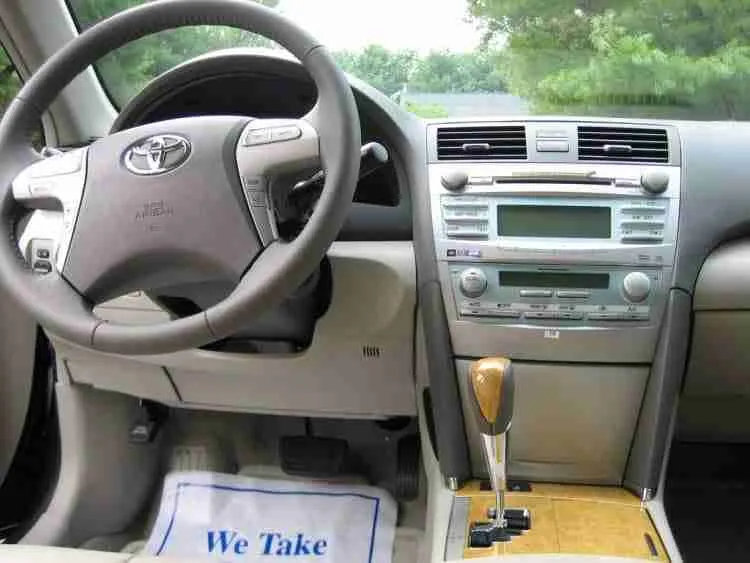How to Fix a Sticky Dashboard on Your Toyota Camry

How to Fix a Sticky Dashboard on Your Toyota Camry?
Exposure to sunlight, heat, and high humidity can melt the adhesive used to bond the layers of the dashboard. Simultaneously, the outer fabric material of the dashboard softens and expands when heated, allowing the melted adhesive to move upwards through the fabric. Over time, the adhesive can cause the fabric to deteriorate, leaving behind a shiny, sticky residue which can trap dust and dirt and create a dangerous glare on the windshield.
Does Toyota offer any help?
Short answer: not really.
Sticky dashboards are a problem common in Lexus and Toyota vehicles. In fact, Toyota was aware of the problem circa December 2011, when Lexus released an information sheet, TSB L-SB-0144-11, revealing that there were some 2006 – 2008 model year vehicles exhibiting sticky interior panels that have a shiny/degraded appearance. Specifically, the condition was noted as being most often present on the Instrument Panel Pad and/or the Door Panel Trim. Lexus stated that revised interior panels had been developed to address the condition. The Lexus Comprehensive Warranty, which lasted 48 months or 50,000 miles, was to cover repairs for this problem.
Several lawsuits (and years) later, however, Toyota has yet to replace melted dashboards as was promised in 2015 with Toyota’s announcement of customer support program ZE6, which extended dashboard warranty coverage on eligible Lexus and Toyota vehicles.
While the only perfect fix for a sticky dashboard may be to have the entire thing replaced, doing so could cost you a few thousand. So, here are a few methods you can try to fix a sticky dashboard yourself.
Method 1: Buy a product specifically designed to clean sticky dashboards.
Sticky Dash Fix claims to be originally developed as a tool to restore and protect 3D-printed medical models and rapid prototypes, which can be degraded by light and moisture due to the materials used in the additive manufacturing process. The product consists of a surface cleaner, which removes sticky plasticizers, dirt, and debris, and a surface coating, which is applied in multiple coats to seal the dashboard surface by forming a thin, strong, and flexible membrane.
Because adding color pigment to the coating significantly reduces light penetration of dashboard surfaces, Sticky Dash Fix offers kits customized to match the color of your car’s dashboard. Each kit includes bottles of Sticky Dash Cleaner and Sticky Dash Coating, two applicators, a microfiber lint-free cleaning cloth, disposable gloves, and an instruction sheet. Not that that you would need much instruction—the procedure to use Sticky Dash Fix is incredibly simple, as follows:
Step 1. Apply the Sticky Dash Cleaner to the dashboard surface.
Step 2. Apply coats of the Sticky Dash Coating until the dashboard no longer feels sticky after drying.
After treating your dashboard with Sticky Dash Fix, you allegedly won’t need to provide any special maintenance. Soapy water should do the trick.
The Toyota Camry Sticky Dash Fix Kit is currently on sale for $39.95. Check it out at stickydashfix.com.
Method 2: Clean the dashboard thoroughly.
With a little patience and elbow grease, you can alleviate the tackiness and glare of the dash by using your own cleaning method(s). However, there are a few ‘don’ts’ to be aware of before you apply a home remedy to the surface. Do not use the following:
- A silicone dressing, which can produce a stickier dashboard than what you started with
- Polish wax or polish cleaner, which can produce an obstructive reflection on the windshield
Materials:
- Microfiber cloths
- Mixture of mild soap or dish detergent and warm water
- (Optional) Q-tips or small brushes
Step 1. Wipe the surface clean of large particles (such as dust, crumbs, pollen, etc.).
Step 2. Dampen a microfiber cloth with the soap-water mixture.
Step 3. Wipe the surface of the dashboard with the damp cloth. Repeat with fresh cloths.
Step 4. Once the surface is no longer sticky, allow the dashboard to dry.
(Optional) Step 5. Use Q-tips or small brushes to clean small, heard-to-reach crevices a cloth can’t clean.
Method 3: Goo Gone and Scotch-Brite.
 This method requires a lot of patience and elbow grease. Youtuber Poor Man Mods was able to fix his sticky dash by squirting Goo Gone onto the affected areas and scrubbing away the residue with a few Scotch-Brite Heavy Duty Scour Pads. Poor Man Mods went through two such pads, so you may want to have a few extra on hand in case your dashboard is in worse condition.
This method requires a lot of patience and elbow grease. Youtuber Poor Man Mods was able to fix his sticky dash by squirting Goo Gone onto the affected areas and scrubbing away the residue with a few Scotch-Brite Heavy Duty Scour Pads. Poor Man Mods went through two such pads, so you may want to have a few extra on hand in case your dashboard is in worse condition.
Method 4: Cover the dashboard.
If all else fails, you can buy and install a dashboard mat/carpet/cover that reduces both the heat build-up and glare of the dashboard area. There are mats available for a range of Toyota Camrys, ranging in price from $40 to $200+. Depending on how strongly you care about aesthetics, you may want to invest in a custom mat that will better fit your car’s dash.
Method 5: Repair the dashboard yourself.
While this method is the most labor-intensive out of the five methods in this article, the average Camry owner can likely complete the following steps with ease:
Step 1. Remove all removable components on the dash, such as A/C vents and panels.
Step 2. Remove all inner bolts holding the dash down. Ensure all bolts are accounted for.
Step 3. Remove the entire dash and clean off the melted adhesive residue with ethanol.
Step 4. Spray a thick coat of emulsified on the dash and allow it to dry completely.
Step 5. Smooth the surface of the dash and apply glue.
Step 6. Wrap the entire dash in a high-quality material of your choice. Alternatively, you could place the cover of your choice instead.
Step 7: Reinstall the dash and the removable components from Step 1.
In the end, know that the problem of sticky dashboards has been an issue in Toyota Camrys for years. There are many online forums to browse that may help you find a solution. To avoid having to clean your dashboard over again, you may want to start parking your car in shade as much as possible, or purchase a sun shade to avoid direct sunlight on the dash and to reduce the temperature of the car’s interior.













No Comment